#oxbow lagoon
Text

Seasons by ET Photographic
Via Flickr:
What a difference time makes! Top shot was taken Feb 2024, bottom was Oct 2022.
#rocky river reservation#oxbow lagoon#north olmsted ohio#cuyahoga county#don't fight it#memory of trees#actually there are 2 oxbow lagoons in ohio but I squinted at google images and I think this is the rocky river one
3 notes
·
View notes
Text
i love you lake i love you ocean i love you stream i love you river i love you creek i love you canal i love you brooks i love you lagoon i love you sea i love you swamp i love you pond i love you bayou i love you cove i love you springs i love you bay i love you estuary i love you delta i love you alluvial fan i love you oxbow lake i love you meander i love you tributary i love you marsh i love you channel i love you confluence i love you wetlands
5K notes
·
View notes
Text
To help clear up some confusion:
A rivulet or streamlet is the smallest form of naturally moving water.
The other forms, in order of size, are brooks, streams, creeks, and rivers, which are the biggest.
The streams which lead into a river are called tributaries.
A canal is a man-made waterway. A defensive canal around a structure is a moat.
A phytotelma (lit. "plant pond") is the smallest form of naturally occurring still water. They form inside of the cavities of some plants.
A puddle is larger than that, followed by a pool.
A pond is larger than both of them, and a lake is the largest. In the UK, they are sometimes called lochs.
An oxbow lake or billabong is a body of water cut off from the river it was formally part of.
A spring is usually where a waterway starts, bubbling up from underground.
A delta is where many streams flow into an estuary before they reach an ocean or sea. They are usually triangle shaped.
However, that's only freshwater.
Larger than a lake is a sea, and many seas make up an ocean, but are often largely enclosed by land.
A channel connects two bodies of water between two landmasses. When one is narrow, it is often called a strait.
A sound is an area of sea usually surrounded by mountains or hills.
A gulf is a part of the ocean which has overtaken part of the land. It is usually almost completely enclosed by land. One with a wider mouth may be called a bay. A smaller bay or gulf is called a cove.
An inlet is a recess along the coast. A deep inlet with steep sides is known as a fjord.
An oasis is a body of water located in a dry or desert land.
A lagoon is a body of water cut off from a larger body of water. Sometimes a coral reef encircles it, creating an atoll.
An archipelago is a group of islands. If an archipelago encloses a reef or lagoon, it is called an atoll.
------------------------------------------------
(Disclaimer: Unfortunately, these are just general descriptions that give an idea of how different geographic features are differentiated. These terms are often used for locations which do not fit the above definitions.)
2 notes
·
View notes
Text

Ancardia's Unusual Animals--the Longgui (or Dragon-turtle)
Classification: Beast (chelonian)
Habitat: Deep bodies of fresh water, especially in the Drakalors, Akimmia, and Tvearban lakes.
The Longgui—known in Commontongue as the “Dragon-turtle”—is among the largest extant reptiles in Ancardia and definitely the largest chelonian currently living in this world. Longgui are massive, long-lived, and highly intelligent and cryptic in their habits very similar to the two true dragon species, and while aquatic they are generally not strong swimmers due to their incredibly heavy bodies and will usually simply walk along the bottoms of lakes, large rivers, and estuaries, nearing shore every several hours in order to take breaths. The average longgui has a head measuring a meter in length and a carapace about 4.6 meters long by 3 meters wide. Due to the horns and protruding scale structures on this creature’s head it lacks the ability to withdraw its head into its shell, but this in no way diminishes the longgui’s ability to protect itself. Much like true dragons, dragon-turtles are very arcanely gifted and possess a natural capacity to summon bursts of fire, cold, and lightning in self-defense. As a result, the longgui have no natural predators and their population is mostly controlled by their dramatically slow rate of breeding, limitations in food supply, and a number of isopod and roundworm parasites which can weaken and slow dragon-turtles enough to further reduce their reproduction rate.
Longgui live for an average of 400 years, or until their parasite load eventually overcomes them with anemia and weakness from considerable age. While longgui grow continuously throughout their lives, most of even the giants of the species over 300 years old do not exceed 10 meters in carapace length. Their metabolism as adults in incredibly slow as well, and longgui have been known to sit on barely-submerged sandbars for more than 48 hours at a time doing very little but stretching up for air. About once every decade, a longgui becomes capable of breeding, and if lucky two fertile longgui will be able to make multiple mile journeys to find each other and dig out a suitable nesting site in marshland, lagoon, or natural oxbow lakesides. Longgui nests are constructed of layers of sand or soil and rotten vegetation, the mound often being several meters high and deep, and the longgui will lay approximately 10-12 eggs within. Only about half of these eggs will be fertilized, the rest acting as decoys should any predators burrow far enough into the nest. Longgui parents will generally leave their nests alone, but if interrupted in laying eggs have been known to become highly aggressive. After incubating for several months, the surviving eggs will hatch into juveniles roughly the size of a pie tin; this is the only time in a dragon-turtle’s life cycle where they are vulnerable to predation, and they must hurry to deeper water to avoid creatures like grizzly bears, dire wolves, owlbears, and sabrecats. Once in the water, they graze waterplants and hunt small crustaceans and molluscs in order to grow rapidly in their first few years, avoiding aquatic predators like bull sharks, large catfishes and pike, and the mishipeshu or bunyip (a close relative of the true dragons). Once they reach a carapace length of a meter or more their hard, sharp-edged shells protect them from any more consistent threat of predation, and their ability to use offensive magic protects them far further.
In the event of an elder longgui dying, a great many carrion birds and carnivorous animals flock to the area to scavenge the multiple-ton carcass, much like the lakeside equivalent of a whalefall. Humanoids also flock to the area, particularly alchemists after rare material derived from longgui and craftsmen after the dense and sturdy shell and horns left behind by the majority of scavenging beasts. Alchemists seek the smaller scales present on the legs, tail, and facial area, and must arrive at the carcass quickly before various birds and rodents make off with these pieces. Armor-crafters have been known to use the shell portions to create unparalleled shields and cuirasses, particularly Hill Giants and Frost Giants.
#ancardia#ancardian homebrew#bestiary#mixed media#creatures#animals#Ancient Domains of Mystery#ADOM#Dnd-like#dragon-turtle#Longgui#not actually a dragon but certainly a big turtle
6 notes
·
View notes
Text
KANA MWAZIBA KULU (Part 2)
The landscape boasts various resources, including spectacular man-made canals, natural and man-made mounds, traditional houses and palaces, shrines, and other sacred sites, along with items of special significance, mostly used as part of their rituals and ceremonies. Additionally, there are roads and footpaths, culverts, natural water bodies such as tributaries, lagoons, and oxbow lakes, as well…

View On WordPress
0 notes
Photo
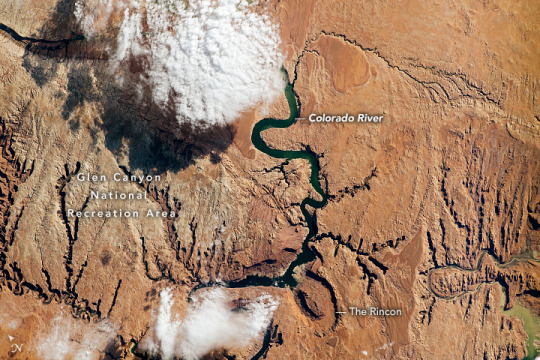
The Colorado River Cuts a Canyon An astronaut onboard the International Space Station (ISS) took this photograph of the Colorado River in southeastern Utah. The river drains a sizable portion of the Rocky Mountain Range and provides water resources to more than 40 million people across seven U.S. states and northern Mexico. The Glen Canyon National Recreation Area in both Utah and Arizona is characterized by high desert with white to reddish-brown sandstone cliffs of interbedded limestone, which is common in the southwestern United States. About five million years ago, the river began carving into these sedimentary rocks, exposing bedrock that dates back approximately 300 million years. This carving, or fluvial erosion, occurred simultaneously with tectonic uplift (the rising of the landmass). The Colorado River now lies in its meandering canyon, which includes a dry, relict oxbow. Uplift has raised parts of Glen Canyon National Recreation Area as high as 10,000 feet (3,000 meters) above sea level. The interbedded limestone includes marine fossils from a variety of shallow aquatic environments of the past, such as lagoons and deltas. Astronaut photograph ISS067-E-175591 was acquired on July 4, 2022, with a Nikon D5 digital camera using a focal length of 400 millimeters. It is provided by the ISS Crew Earth Observations Facility and the Earth Science and Remote Sensing Unit, Johnson Space Center. The image was taken by a member of the Expedition 67 crew. The image has been cropped and enhanced to improve contrast, and lens artifacts have been removed. The International Space Station Program supports the laboratory as part of the ISS National Lab to help astronauts take pictures of Earth that will be of the greatest value to scientists and the public, and to make those images freely available on the Internet. Additional images taken by astronauts and cosmonauts can be viewed at the NASA/JSC Gateway to Astronaut Photography of Earth. Caption by Amber Turner, Jacobs, JETS Contract at NASA-JSC.
0 notes
Text
Chief garbage taster as fifth grade Halloween gag
at Henry Kline Boyer Elementary School
interestingly enough landed me a grubhub grab bag.
I rooted thru poetry anthology of mine,
and came across an unpublished poem
by one obscure poet (me), whose trademark
wit and wisdom hallmark
cardinal characteristics
of posthumous fame and fortune
largesse most likely
tabby bestowed upon grand kittens -
appended courtesy Facebook
since none of my two (both
twenty something aged) darling daughters
opted to be fruitful and multiply.
Courtesy brainchild of dear old dad
(actually when alive
and in his prime, he happened to be spunky
as an overgrown lad),
unanimous assent between him and mother
(she also when young, his junior by a tad)
both agreed their quiet natured son
(yours truly plus younger sister)
best be outfitted as rubbish.
Anyway, as a Halloween costume,
one year during early grade school,
my father got the brilliant idea
for his sole son to be dressed
with one of a kind getup.
Missus Shaner – long since gone to dust
(the talon clawed, shriveled
relic of a dinosaur,
who taught fifth grade)
gave me first prize,
and subsequently felt so convinced
about authenticity of this kid
being “privileged white trash”,
she notified another kid
dressed as a janitor
to dispense with me
in the school dumpster.
The sanitation disposal company
drove me (and subsequently
dumped yours truly
among the real rubbish
in the dumpster)
to nearest landfill
loaded with all kinds of junk
such as food scraps, recyclables,
and soiled diapers.
Over a short span of time,
the detritus commingled
into one noxious brew
of a despicable fly haven,
whereby jiggling lifelike maggots,
jumpstarted, lunched, and nursed putrescence
re: reeking and teeming vibrantly
with yum zuck for a swamp thing,
I seemed to be metamorphosed
into sewer rat as if by some cruel hoax.
Nothing prepared, neither sickened
nor violated senses
of smell, sight, taste, and touch
to the maximum factor
intolerant of odoriferous odious stench.
Each pestilential assault
issued an appalling refrain
courtesy Fiona Apple's:
The Idler Wheel Is Wiser
than the Driver of the Screw
and Whipping Cords Will Serve You
More than Ropes Will Ever Do.
Before mine myopic bespectacled eyes
(smarting from constant comet drubbing irritants
(which glasses – rather bifocals –
caked with smudge good as naught),
stayed wide shut from inundation
of said corrosive gaseous shaped
oxbow lake comprising wreath like wisps.
Liberty vis a vis in sight
envisioned visibly threatened offshoots
of tendril spikes; snaking sneakily,
sordidly slithering silently,
yet straightaway as a scene
from some spooky sideshow
or “haunted house”.
This ugly slop
splashed upon mine formerly
pristine academic uniform
appeared near identical
to the grub hub (the lunch lady served)
splattered sundry speckles
sans sundry detritus,
which found me writhing with nausea.
Thee nasty muck and mire
found this formerly introverted boy
transformed into a sponge bobbing
squarely panting creature
from the black lagoon,
whose skinny sea legs
sought semi-solid surface
to stand upright position amidst
variegated flotsam and jetsam.
Dishabille appearance acquired
a fresh splattered coat of rancid slimy
green eggs and ham with bacon
covered gangly arms
(among other bit pieces of moldy clothes,
food and iconic library oddment)
ricocheted unpredictably as trash truck
violently shook up and down
all night long en route on this highway to hell
found me thunderstruck
(before being buried alive in Moyer’s Dump),
which toxic brew would be declared
a SuperFund Site
and shuttered in the near future.
Once Robert Hall wardrobe
affixed with a capital one fancy feast
of grateful dead roadkill,
kickstarter from some automotive contraption,
and plenti of fish heads
(with thine spongy bobbing square pants
trimmed with lovely bones),
I felt indistinguishable
from regular riffraff riding shotgun.
When random trucker parked and stopped,
the awful bin laden made ready
to empty contents within the mountain
of olfactory noxious material.
A thought occurred,
that now might be the golden
(or rather gook steeped) opportunity
to extricate myself
from morass of mish mashed,
spud nicked mine
linkedin kindled juggernaut,
icky first class bric a brac.
1 note
·
View note
Text
A Different View~North Fork St Lucie River
A Different View~North Fork St Lucie River
-North Fork of St Lucie River surrounded by by development, Port St Lucie, Florida. Distinctive oxbows lie south of Prima Vista Blvd. Aerial photo by Ed Lippisch September 16, 12.15pm.
The above aerial of the North Fork of the St Lucie River is the second in my recent series entitled: “A Different View,” as Ed and I feature areas of the St Lucie River/Indian River Lagoon other than the Sailfish…

View On WordPress
#A Different View~North Fork St Lucie River#Aerial North Fork St Lucie River#change our ways#Ed Lippisch North Fork Aerial#north fork#North Fork St Lucie River#Port St Lucie North Fork St Lucie
0 notes
Photo
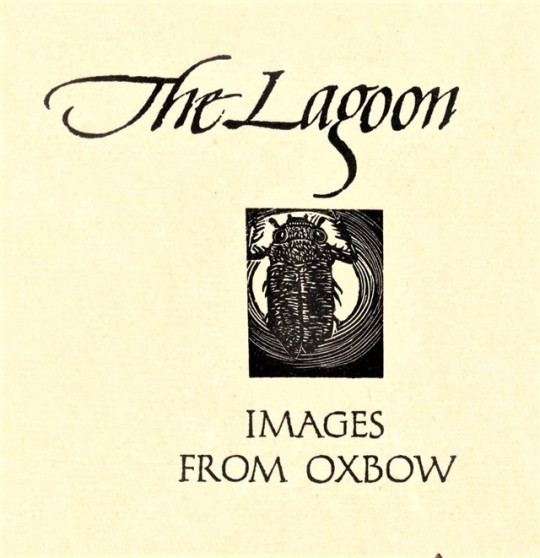

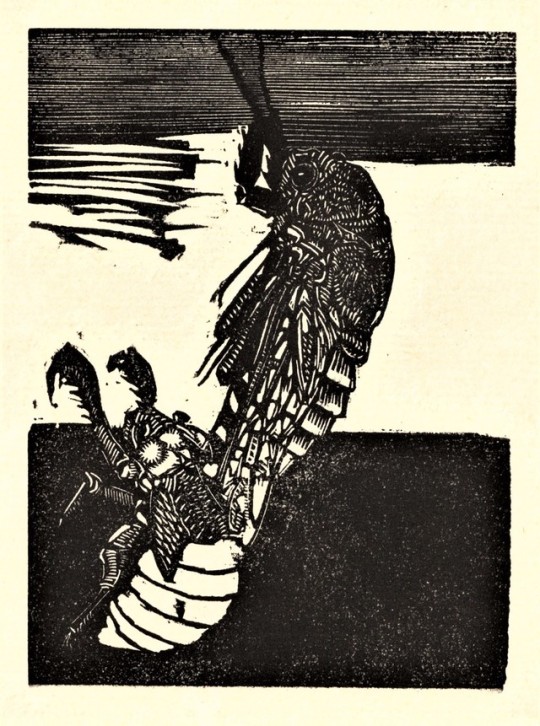
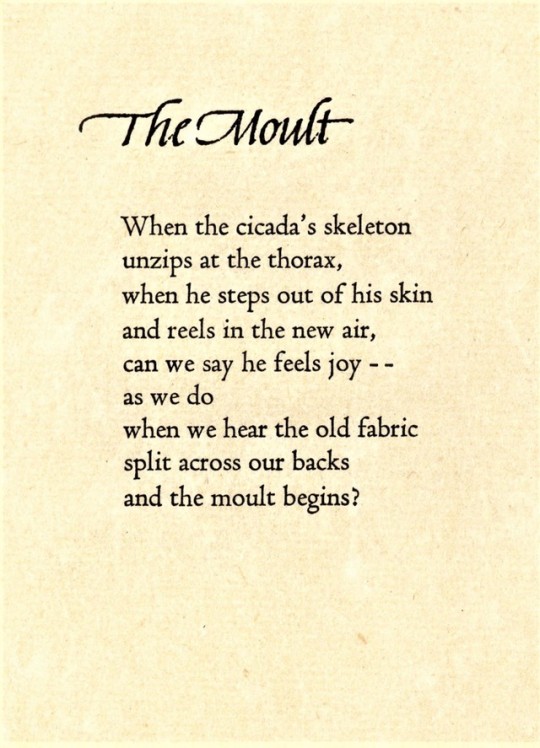

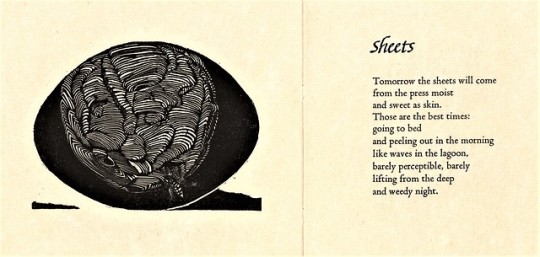
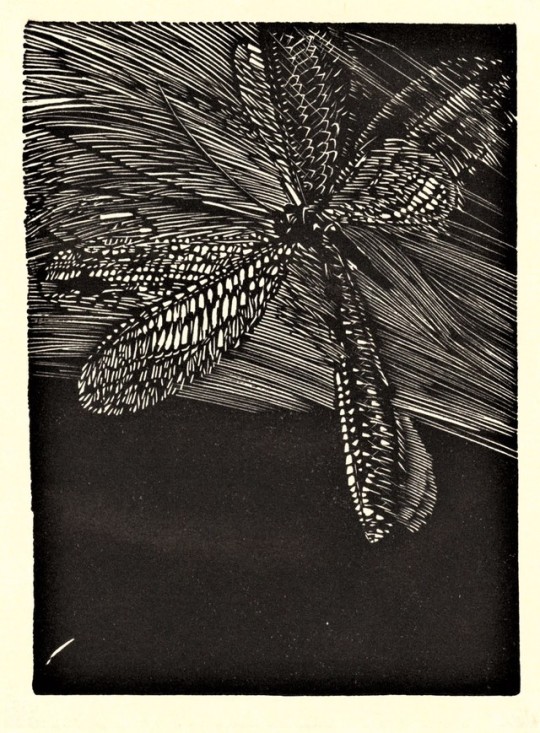
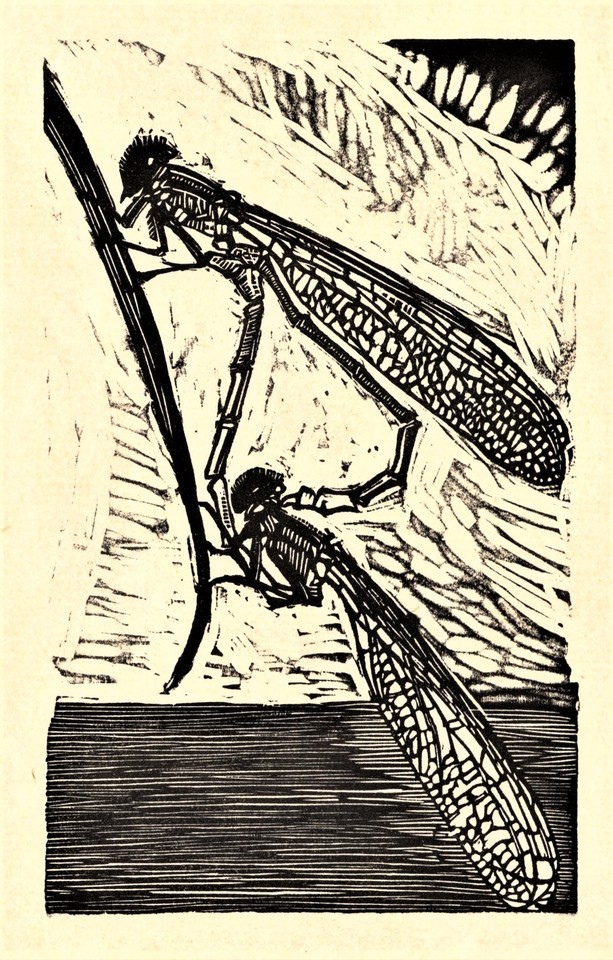
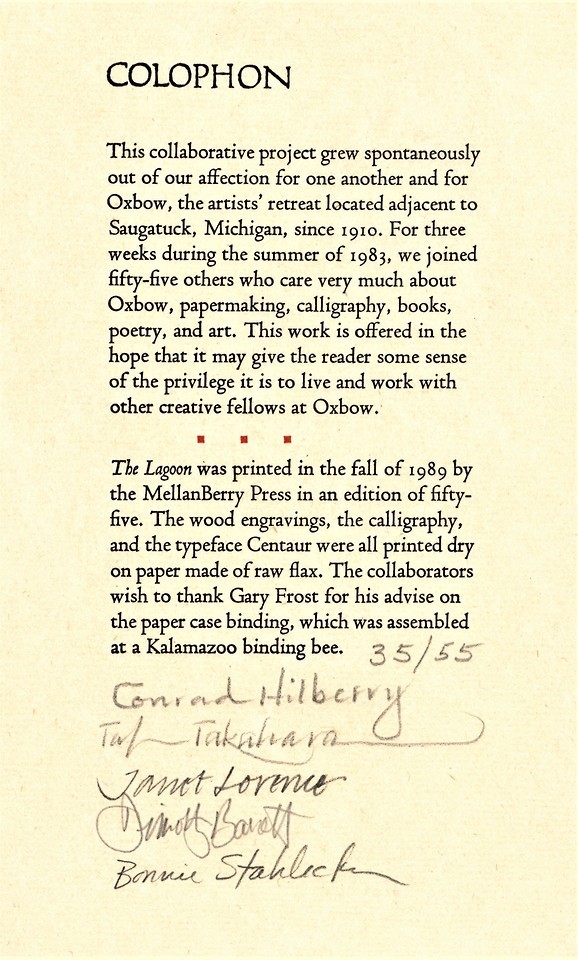
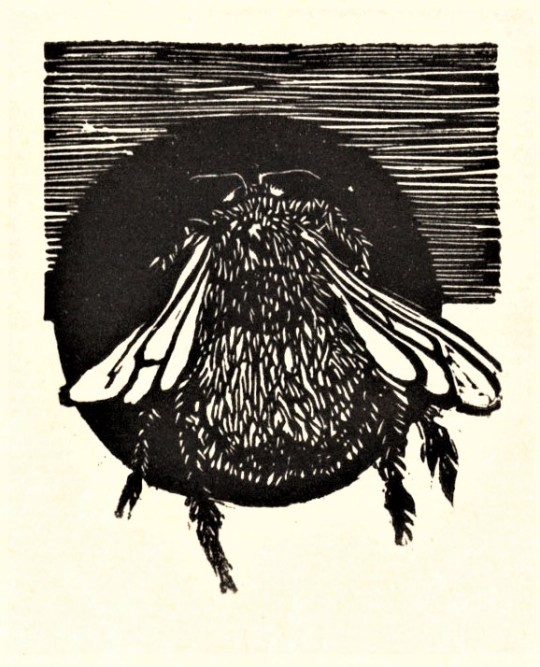
It’s Fine Press Friday!
This week we present The Lagoon: Images from Oxbow, a collaborative book printed by the MellanBerry Press in the fall of 1989 in an edition of 55. It features poems by Conrad Hilberry, engravings by Takeshi Takahara, calligraphy by Janet Lorence, paper by Timothy Barrett, and design by Bonnie Stahlecker. The wood engravings, calligraphic plates, and Centaur types were all printed dry on paper made of raw flax.
The colophon reads:
This collaborative project grew spontaneously out of our affection for one another and for Oxbow, the artists’ retreat located adjacent to Saugatuck, Michigan since 1910. For three weeks during the summer of 1983, we joined fifty-five others who care very much about Oxbow, papermaking, calligraphy, books, poetry, and art. This work is offered in the hope that it may give the reader some sense of the privilege it is to live and work with other creative fellows at Oxbow.
Our copy is signed by all five participants, and is yet another generous donation from our friend, Jerry Buff.
View more Fine Press Friday posts.
–Sarah, Special Collections Graduate Intern
#The Lagoon: Images from Oxbow#MellanBerry Press#Conrad Hilberry#Takeshi Takahara#Janet Lorence#Timothy Barrett#Bonnie Stahlecker#Fine Press Friday#Fine Press Fridays#letterpress#engraving#oxbow#insect illustration#insects#Sarah Finn#sarah#Jerry Buff#wood engravings
87 notes
·
View notes
Photo

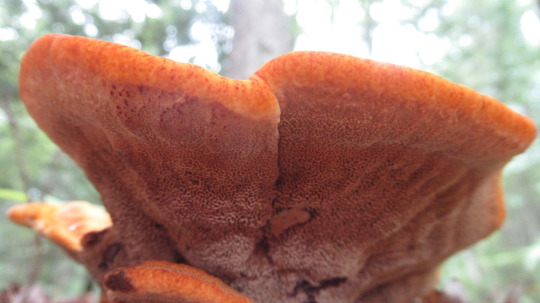


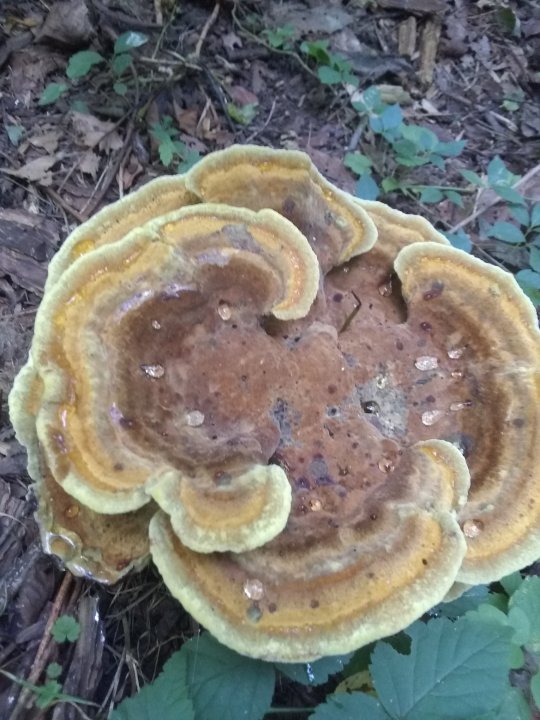
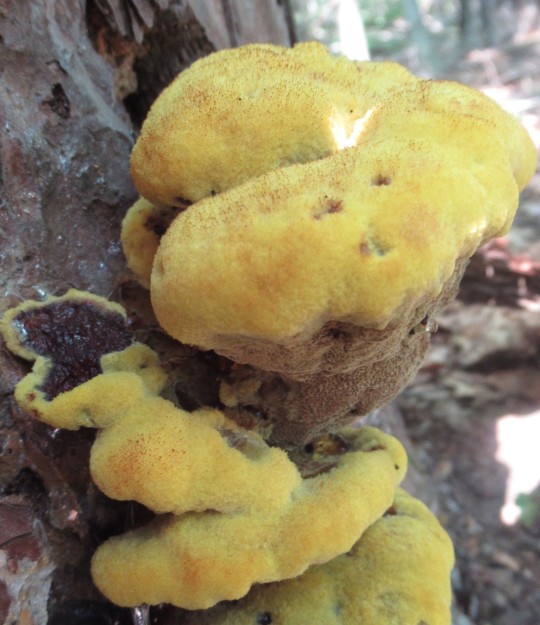
Phaeolus schweinitzii
Dyer’s polypore
Look there! What is that?
I explored the summery southern quarters of North Chagrin reservation cautiously.
I’d been coming here for years, and was well acquainted with its north side. I’d walked and climbed far off trail from Oxbow Lagoon to Strawberry Lane Pond.
Squire’s Castle, an abandoned Clevelander millionaire’s hobby project from the 1800s, is clear and crisp in my mind. I’ve seen it so many times, I can imagine it almost as clearly as my eyes can see it.
Trickling tributaries feed the great Chagrin River through mossy, acidic hemlock forest ravines where underbrush is scarce besides solomon’s key, various ferns and mosses, and birch trees, rare in Ohio, companioning plentiful hemlock conifers.
I was wandering part of the forests very new to me when I saw an old friend.
Dyer’s polypore!
I practically skipped over to it to get a better view.
Some mushrooms give me an inexplicable satisfaction. Like seeing a friend when you weren’t intending to meet.
I’m not sure I’d call them favorites. But I have a strange connection to them I knew was there from the first time I saw them.
This velvety, zonate yellow poplpore, with its fluffy, furry flesh and orange to brown concentric rings never fails to bring a smile to my face.
As you can probably guess, it’s well loved by hobbyist dye makers. Several mushrooms can be used for this purpose.
I took some P. schweinitzii home with me recently to expertiment making my own. Wish me luck! I’m a mushroomer, not a yarner.
#Mushrooms#Fungi#Fantastic fungi#north chagrin reservation#nature#forests#hiking#foraging#natural dye
29 notes
·
View notes
Text
Definition of different Water Bodies
HUMANKIND has built civilizations around water. From the very beginning, we have subsisted on and resided near water. Let us explore the definition of the various forms of aquatic geology. The precise definitions could be very blurry and confusing, however.
What exactly is a sound, a sike and a ghyll?
What’s the difference between a bight and a bay?
What are the different words for a small stream?
Living on the American seacoast, can make you familiar with shoals and inlets. Living in Norway or Scotland can make you familiar with the definition of the fjords or lochs respectively. Let us explore many different types of bodies of water that define the wetter parts of the world.
To understand the distinction between the most common terms for flowing water (anything with a natural current moving from high to low), it is roughly defined by size.
There is an old saying which goes as,
“one can step over a brook, one can jump over a creek, one can wade across a stream and one can swim across a river.”
A stream is the generic term for flowing water.
A river is the largest form of stream
A creek is a small stream
A brook is an even smaller stream (used in Old English)
A rivulet is a very small stream or baby stream
A rill is a very small brook or rivulet
A beck is another name for small stream
A kill is an old Dutch term in colonial New York for creek or stream
A streamlet is a small stream
A runnel, also called runlet, run, rundle or rindle is a small stream or brook or rivulet
A brooklet is a small brook
a bourn is a small stream, particularly one that flows intermittently or seasonally
A beck is a small river or synonym for stream or brook
A crick is a variation in the pronunciation of creek in parts of the U.S.
A ghyll is a narrow stream or rivulet, or a ravine through which through small stream flows
A syke or sike is another Old English term for small stream, especially one that is dry in summer
A burn is a large stream in Scotland and England
A spring is when water flows up from under the ground to the surface.
A bayou is very slow moving water, referring to a tributary of a lake or river that is sluggish, marshy as well as filled with vegetation.
A tributary is a stream that flows into a larger main stream or river,
A distributary is a stream that branches off from the main river and flows away from it.
A meander is a turn or bend in a winding river.
A freshet is a sudden flow of freshwater from rapid heavy rain or melting snow after a spring thaw. (It can also refer to the place where a river or stream empties into the ocean, merging freshwater with salt water.)
An estuary is where a river empties into the sea—the place where the mouth of the river meets out the ocean tide.
The headwaters is the source, the very beginning of a river or stream.
A gulf is the largest of these broad inlets, and tends to have a narrow mouth opening to the sea.
A bay is smaller than gulf and also largely landlocked but with a wider mouth.
A cove is a small recess or indent in the shoreline that forms a sheltered nook with a narrow entrance to the sea.
A bight is a wide indent of the shore, like a bay but smaller and broader—these bights were historically a perfect safe harbor for pirates.
The ports are defined as any geographical area where ships are loaded and unloaded.
A roadstead (or “roads”) is a sheltered body of water near the shore but slightly outside the enclosed harbor (place where ships anchor while they wait to enter the port).
A lake is the term for a large body of water surrounded by land on all sides.
A pond is just a smaller version, and often formed artificially.
A mere is a shallow but broad sheet of standing water, particularly in Old English dialects or literature.
A puddle is even smaller and shallower, typically consisting of dirty rainwater.
A pool is a deep body of still freshwater.
A tarn is a small pool or lake found in the mountains, sometimes with steep banks formed by a glacier.
An oxbow lake (named for its characteristic U-shaped curve) is formed when a wide bend in a river is eventually cut off from the main stream entirely by erosion and becomes a free-standing pool of water.
A loch is a lake or inlet of the sea that is nearly landlocked primarily in Scotland.
An inlet is a place where the sea projects inland as an indent in the shoreline like a bay or gulf.
An arm of the sea or sea arm is a place where the sea projects inland like a more narrow water passage opening from the coastline.
A firth is a regional word used in Scotland, is similar in that it’s a narrow inlet of the sea, or a large sea bay, or long arm of the sea.
A fjord is a long, narrow inlet flanked by steep cliffs on three sides and is connected to the sea. It’s formed when a glacier (common along the Norwegian coast) cuts a U-shaped valley below sea level that fills with sea when the glacier retreats.
A sound is an ocean inlet quite larger than a bay and wider than a fjord. It is specifically a part of the ocean between two bodies of land, like a wide inlet which is parallel to the coastline flanked by a nearby island.
A channel is also constrained on two sides by banks, but is specifically a bed of water that joins two larger bodies of water.
A strait is similar to a channel only narrower.
A lagoon is a shallow elongated body of water separated form a larger body of water by a sandbank, coral reef or other barrier,
A barachois is a coastal lagoon separation by the ocean by a sandbar that may periodically get filled with salt water when the tide is high.
A billabong defines where a river changes course and creates an isolated stagnant pool of backwater behind where the former branch dead ends.
A narrows is a narrow water passage where a strait or river passes through a vertical bed of hard rock.
A lee is a natural body of running water flowing under the earth
Read More Topics:
Sewage Treatment Plant Manufacturer
Effluent Treatment Plant Manufacturer
Commercial RO Plant Manufacturer
#sewage treatment plant manufacturer#effluent treatment plant manufacturer#wastewater treatment plant#water solutions#commercial Ro Plant manufacturer#Industrial Ro Plant manufacturer#STP Plant#ETP Plant#Industrial RO Plant#Netsol water solutions
1 note
·
View note
Text
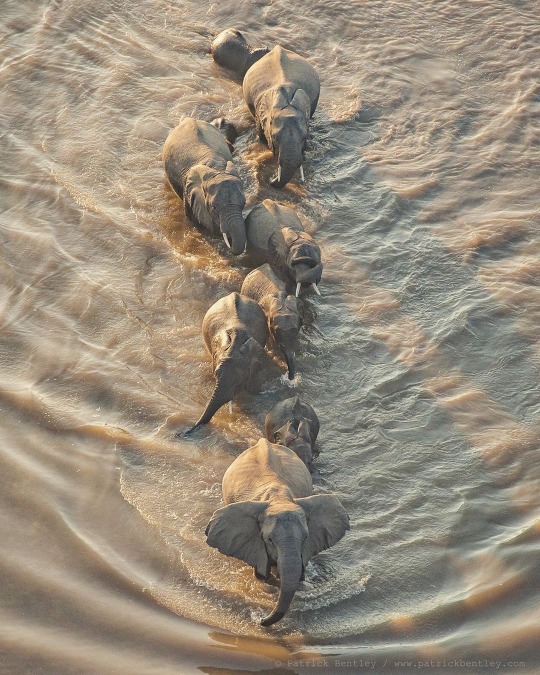
A family of elephants crossing the Luangwa River at dawn.
The Luangwa River is the most intact major river system in Africa and is the life-blood of this 9059 km2 Park.
Experts have dubbed South Luangwa National Park to be one of the greatest wildlife sanctuaries in the world, and not without reason. The concentration of animals around the Luangwa River, and its oxbow lagoons, is among the most intense in Africa.
╭ⓕ━━╮𝓕𝓸𝓵𝓵𝓸𝔀
┃ⓞ┎━╯ ╰⊶❤️⊶╮
┃ⓛ┖━╮ ╭⊶❤️⊶╯
┃ⓛ┎━╯ ╰➤ www.kim.tours
┃ⓞ┃
╰ⓦ╯
🙏 Thanks for looking!
✧—————————————————✧
𝘚𝘱𝘰𝘯𝘴𝘰𝘳𝘦𝘥 𝘉𝘺
🌍: www.kim.tours 📧: [email protected]
Follow @kimzebraadventuressafaris
Tag 👉 #kimzebraadventuressafaris
Photo C@patrickbentleyphotography
More - https://kim.tours/kenya/safari
More - https://kim.tours/rwanda/safari
More - https://kim.tours/uganda/safari
More - https://kim.tours/tanzania/safari
✧—————————————————✧
0 notes
Text
potentially
Rise or fall the scene is set: the pyramid of Christ interrupt the pyramid reflect...
By potentiality of inclusion the mode of interruption is given and by one word or word by another the truth will be the individuals truth and otherwise a truth spoken.
The mountaintop looks are cold but these looks can see more, the wisp whispered by all that could be seen and the uncertainty in thinking can be incomplete or even complete but ever absent and so say the pyhschic advertising agency and the organised seance flashmobs and these are the operators on lower slopes where the direction is an inversion of the pyramid above and the methodology of separation defines the f2 differential in (f - f1)/(f -f2) to determine values f1 and f3 and the subset f data shows the methodology of separation is being used to make absorption appear as understanding. And everything has a value, even the science of interruption. And the value is relativistic, and has many axis.
The methodology of separation covers the science of interruption with just what u like and that can be lume or that can be shade and by both it is said only darkness can be worn when using negative translations of a positive. And by these means in the pyramid reflect where any translation may be a translation meant the subset fdata says – ‘therefore the application of disequilibrieted datasets in the science of interruption translates empathy as indifference.’
And the picture began to change and the picture changed looked different and the data used to describe the painting upon the wall directed the brushstrokes and by rise or fall one moves as the scene describes. The reflect never left their frame even by the lagoon at hega stirronia and they were asked ‘if in a non directional space subjective relation must define negative and positive, then how emotional is that data (f +sf)=e -sf2 and OSF did not answer though began lots of chatter about the uncertainty of randomness, by sampling from hypothetical dataset 'random thoughts and randomness of associated emotion.'
the first time you walked away, I watched you turn your back. the 2ndtime you walked away gave you 4 legs; the colour red appears b4 the 3rd OSF said as 1 was listening to the echoes of nightmares, finding them all to be broken dreams and so sometimes they stay in deep silent valleys so they can be heard, the purple clouds will tell us why and when the snow is too deep to walk above will the map match what we see.
And by the oxbow that many faces saw the faces looked now as the faces had b4 and the water muddy points and black water set in shade of the thicket and tree tree by the river to the side and by the bank we say ‘that sweet pudding you made every holiday, flavours the mouth that speaks tomorrow,’ and they move differently to how they r heard in the texts in this moment of interuption now at hega stironnia and it can be seen that 1of the fundementals of OSF s philosophy of data observes in reflection - beyond functionality - what makes data inactive, and that termed active.
And it is always about the failure of truth and there is aspect unseen to see in variant effect and so that: I called u cute all week; 12 times. On the 13th I called you feelow. And so see that 'I am happy,' they said; but did the metaphor or the literal come first. And so this 1 of the OSF walk between baby trees and they listen as they say they fear 2b as clouds r in the sky b4 them. And here the faces are always the same and yet r every time different and that is how they look everyday in neverhigh if they knew they would be upset but they would be; upset. U know? And if they knew they would be upset but they would be; upset. And remember cats don't eat cows.
And interruption may take 1 2 1 of 2 areas and both area may use the same nomenclature and during 1 time of interruption a wisp sat by their very own oxbow lake and asked those about them: 'whys r ur hand not strong enough to hold mine,' black waters reply was 'it's not my hand u need hold of' and by that measure the reflection moved beneath from above and interruption moved the pyramid that is to 1 of the OSF by the oxbow waters that were and were so seen by measure of the word or by measure of a dream.
And if interruption can direct in 1 of two ways and both may b called the same exact thing then how may one know that a name truly is spoken by 1 or another by this point of conversion – after all did you know u can join up all the stars in2 triangles, the cow candy lattice shows you that... and in such measure randomness may appear to a person as an impression. And the impression may be pretty and set in portrait frame and the faint impression of randomness is that of a pattern and here the value of data points in the 'pattern' can only b described by the intention of their collection and they can be collected anywhere and from places 1 never knew or saw by sea or had by any measure made. And here they say the science of interruption explains the hiccups that never go away, as the individual is taken to a point of conversion.
in neverhigh all the words sound the same and with 10 clocks u have a greater probability of measuring the true length of a day, though 11 may still be inaccurate and affiliation draws the curtains, solitude never opens them and freeing the girl from the dolls house, the door closed on her green mouse; disequilibrium is the science of interruption by state to state of that state met.* in neverhigh all interruption vectors fall; the individual ‘batman is evil becos’ observes an interruption vector mutate the data; using (f - f1)/(f -f2), the interruption is contained within the f🔄 f1 permutation and the black iron wreath d roundn round itself, such a trail 2untangle. neverhigh, the promenade; there r less walks that don't forma full circle and if it is all happening below there is no good in looking above and the easter egg never sees its empty box.
*where science is an intention and not occurrence
0 notes
Text
A GLORIOUS THOUGHT EXCURSION: On John Olson’s Novel In Advance of the Broken Justy

https://bookshop.org/a/8227/9781935835172
John Olson's thoughtful and often humorous new novel, In Advance of the Broken Justy, opens with a somewhat Kafkaesque quest to find medical attention for the narrator's wife's infected eye late at night in Paris during a doctor's strike and ends on January 8th, 2015 with news of the previous day's terrorist attack on the Charlie Hebdo offices playing on the television in their hotel room as they prepare to leave for home.
In the pages between the personal crisis and the international one, we are introduced to the oddball mix of neighbors in the narrator's thin-walled building who are driving him and his wife, Ronnie, crazy with noise from construction projects, stomping feet, and rather explicitly audible sounds of digestive functions from a neighboring bathroom. Noisy neighbors are enough to drive any introverted, bookish homebody nuts, but our unnamed protagonist tells us, during a seemingly obsessive and often hilariously aggrieved section of narration reminiscent of Thomas Bernhard, that he additionally suffers from hyperacusia — a heightened sensitivity to noise, and tinnitus — ringing in the ears, as well as Generalized Anxiety Disorder for which he has been prescribed a variety of antidepressants through the years.
It's not only their immediate living situation that is cause for aggravation, the couple are also dealing more generally with a growing dissatisfaction with life in rapidly-changing Seattle. Olson writes that his dislike of Seattle, “evolved over a period of time, like an allergy that starts out with a minor rash and then grows into strange secretions and the constant application of topical ointments.” As their disaffection with Seattle grows, so does their love of Paris. “...we each felt an attachment that had become deeply emotional, like a drug. We had become addicted to this city. It inhabited us, as Ronnie put it.”
The love of Paris among certain artistically-inclined Americans has a longstanding literary and cinematic history, of course. Mr. Olson's novel continues a lineage tracing back at least as far as Ernest Hemingway's A Movable Feast and F. Scott Fitzgerald's “Babylon Revisited” through Richard Yates's Revolutionary Road to Woody Allen's Midnight in Paris. Unlike Gil Pender, the protagonist of Mr. Allen's film, who is mostly enthralled with fantasies of Cole Porter, Hemingway, the Fitzgeralds, Gertrude Stein and other American ex-pats in Paris during the Jazz Age, Olson's two protagonists are most interested in actual French poets, writers and artists such as; Rimbaud, Georges Perec, Michel Tournier, Gaston Bachelard, Raymond Queneau and Pierre Michon. And while their yearning for Paris is similar to that of the couple at the center of Revolutionary Road, it is a rather more grown-up and grounded love of the City of Lights. Olson's protagonists are a pair of older, working-class poets not young, upper-middle-class, suburban dilettantes like Yates's Frank and April Wheeler.
In addition to their dissatisfaction with home and city, the couple are also dealing with the loss of their beloved car, the broken Subaru Justy of the novel's title. After attempting to adapt to a car-less life, including several comic misadventures with public transit and Car2Go, the narrator takes some money out of savings to buy another used Subaru but somewhat spontaneously decides he'd rather take a trip to Paris than own a car again. Ronnie agrees. Plans are made, tickets are purchased, and their ongoing study of French is kicked into a higher gear. Away they go.
The narrator alludes to dark and outrageous moments in his past, back when he was still drinking and taking drugs. “At the age of eighteen, I left my father's house and struck out for California, following the scent of sex, drugs and rock 'n' roll. I was into Dylan and the Rolling Stones. I liked the Beatles, but they remained a bit too wholesome for my rebel-without-a-cause setup. And after reading Aldous Huxley's seminal essay, The Doors of Perception, I had a raging desire to experiment with psychedelic drugs.”
He tells briefly of getting beaten up at a New Years Eve party in Burien, attending Alcoholics Anonymous meetings, and three failed marriages. One suspects Olson could write some fine fiction of wild times, drunkenness, heartache and despair in a Kerouacian or Carveresque vein if he felt the urge to mine his past, but part of what I love about this novel is that it doesn't do that. The image of the artist as a young wild man is a popular one and there have certainly been more than enough misbehaving poets, musicians, painters, novelists and so forth to give that cliché some weight, but what makes an artist an artist is serious, longstanding dedication to one's art. It's refreshing to read a novel that dispenses with the youthful misbehavior in a few short sentences and instead depicts the couple at its center as actual grown-up artists.
In Advance of the Broken Justy is not a novel which glorifies the wild kicks of youth or wallows in the despair of drunkenness and divorce, but rather one which celebrates more mature, quiet kicks like the contemplation of works of art in the Musée d'Orsay, the Louvre, and the Georges Pompidou Centre. It is a celebration of bookstores not barrooms. The narrator and Ronnie go on a sort of literary safari, with guidance provided by a list of the best bookstores in Paris received via email from the French poet Claude Royet-Journoud, and enjoy a cafe visit with the poet and translator Michel Deguy.
“One of the main reasons I wanted to go to Paris was so I could stand in a real bookstore once again before I die,” Olson writes. “The bookstores in the United States have deteriorated into something little better than a gift shop, or those book and magazine shops you sometimes see at the airport. Trashy titles. Nothing of any real interest.” He's not grown so jaded that he's lost all perspective, however, and can still see quality on those rare occasions it may be found. He goes on later in that passage to praise Elliott Bay Books and Open Books and elsewhere declares Magus Books in the University District to be one of the best, if not the best, used bookstores he's ever been to.
While at certain points it's clear that the author's imagination is at play, much of In Advance of the Broken Justy reads close to straight autobiography. That, of course, does not necessarily mean that it is, but the pleasures of reading the novel, for me, were often more akin to those of nonfiction. David Shields, among others, would argue that the distinction between fiction and nonfiction is meaningless. Whiile there is some validity to that stance in that in either case the author is working with a blend of memory and imagination, I think it is a bit of an overstatement. Phillip Lopate writes in a section of To Show and To Tell: The Craft of Literary Nonfiction in which he compares and contrasts the tendencies of nonfiction versus those of fiction that, “What makes me want to keep reading a nonfiction text is the encounter with a surprising, well-stocked mind as it takes on the challenge of the next sentence, paragraph, and thematic problem it has set for itself.... None of these examples read like short stories or screenplays; they read like what they are: glorious thought excursions.”
It is Olson's surprising, well-stocked mind which is of the greatest interest here, the consciousness which regards what happens more so than the particulars of what happens, that takes interesting digressions into considerations of the work of Bob Dylan, Marcel Duchamp, Georges Braque, and organic chemist August Kekulé among others. Of the other books I've read recently, it is Patti Smith's second memoir, M Train, I find it most similar to in both tone and content. Smith, the poet-rocker legend, and Olson, the poet's poet who can count luminaries such as Michael McClure, Clayton Eshleman and the late, great Philip Lamantia among his fans, are exact contemporaries, Ms. Smith being the elder by only a matter of months. Their influences overlap to a considerable degree. Both books weave together narratives of domesticity and travel. Both books present the day-to-day lives of practicing artists and consider the lives of their artistic influences. Both books recount journeys to literary sacred ground in search of a sort of spiritual contact high with forebears and idols.
Mr. Lopate's phrase, “glorious thought excursions,” seems like the perfect description of much of Olson's output. Fans of his prose poetry will find moments replete with the reeling riffs of surrealistic, hallucinatory lyricism familiar from his books such as Oxbow Kazoo, Echo Regime, Logo Lagoon and Eggs & Mirrors in the pages of In Advance of the Broken Justy. Preparations for the sale of their 500 square foot condo and a move away from their infuriatingly noisy building (preparations for naught, as it turns out, for neither sale nor move ever transpire within the pages of the novel) instigates a stream of thoughts on the nature of reality leading eventually to the following passage:
“When consciousness meets reality the result is milk. Traffic lights blossom into prayer wheels. Laundry folds itself into armies of tide pool angst and marches around like generalities of floral chambray. Rain falls up instead of down. The acceptance of frogs liberates bubbles of pulp. Time sags with basement ping pong tournaments. Garrets ovulate glass bagatelles. Realism percolates prizefight sweat. Details sparkle like crawling kingsnakes in the mouth of a Mississippi attorney.”
In Advance of the Broken Justy is a thoughtful, grown-up novel for the sort of thoughtful, grown-up readers who seek out real bookstores and is not likely to have much appeal to fans of those trashy, escapist titles found in the sad, little book and magazine shops in airports Olson derides.
Review by Steve Potter. Previously appeared in A Screw in the Shoe from Golden Handcuffs Review Publications.
0 notes
Text
Fall in Love with Botswana
New Post has been published on https://tagasafarisafrica.com/africa-travel-news/extraordinary-places/fall-in-love-with-botswana/
Fall in Love with Botswana
“Safari: A world without boundaries. A world of romance and elegance. A personal adventure and a way of life.”
– Ralph Lauren
There are few experiences in life that match up to the romance of a safari. When it comes to travelling with your loved one, an experience in the African bush must surely rank as one of life’s top adventures. There’s the thrill of being up close to Africa’s wild animals, experiencing new senses – from the smell of wild sage, a powerful reminder of the bush – to seeing new species or behaviours: a stalking lioness, a bird of prey soaring above, or simply observing the beauty of being in a wild area, taking note of the trees, the music of the riverside or the evocative cry of an African fish-eagle.
At our Wilderness Safaris camps and lodges, there is no shortage of wonderful activities to try – ideal for creating long-lasting memories with your partner. Below, chosen in no particular order, are eight safari camps that are ideal for couples wanting to share in a life-changing and romantic adventure in some of Africa’s most beautiful wilderness areas.
Little Mombo – Elegance, Intimacy, Sophistication
Both Mombo and Little Mombo guests are spoilt with views of a floodplain that hosts an astonishing variety of wildlife. The abundance of life found here has accorded the area its name, “Place of Plenty.” With just four tents, Little Mombo is ideal for couples and small groups.
Enjoy twice-daily game drives, delicious bush brunches, private dining, and, if you feel like working up a sweat, make use of the gym, or enjoy quality time unwinding with a treatment at the spa. At night, slink into a bubble-filled bath, or cool off in your private plunge pool.
Little Mombo – Discover More
King’s Pool – Romance and Royalty
Steeped in nostalgia and named for Scandinavian royalty, newly-renovated and sublimely elegant King’s Pool overlooks a handsome oxbow lagoon of the same name in the Linyanti Wildlife Reserve. Activities include day and night game drives, walks and a nearby hide for photography, as well a scenic helicopter ride – a thrilling opportunity to marvel at the formation of the Linyanti and its wildlife from above.
Another highlight is a ride upon the Queen Silvia barge – enjoy watching the sunset and toasting the day with your favourite drink – it doesn’t get much more romantic than this…
King’s Pool boasts nine luxurious thatch and canvas rooms, each with a large bedroom area and lounge leading to a verandah that soaks up the gorgeous views. At night, enjoy sitting under the stars in the camp’s open-air ‘kgotla’ – a wonderful way to immerse yourself in the beauty of the African night, listening to the melodies of insects and frogs while sharing stories around a crackling campfire.
King’s Pool – Discover More
“Why is it you can never describe the emotion Africa creates? You are lifted. Out of whatever pit, unbound from whatever tie, released from whatever fear. You are lifted and see it all from above”.
– Francesca Marciano
Abu – One of a Kind
Abu’s six luxurious explorer-style tents are just one element of an experience that leaves a lasting impression on every guest who visits. The camp offers the extraordinary privilege of interacting with and meeting the Abu elephant herd. Apart from this, activities include daily game drives, walks (on request) and mokoro trips to take in the diversity of game in the area.
For a romantic and unforgettable night’s sleep make sure you request the Abu Star Bed… The raised platform is above the elephant boma, so you’ll be lulled to sleep by the contented rumbling of the Abu Herd below. Other highlights include a scenic flight by helicopter over the Okavango Delta or a massage to unwind in the comfort of your bush bedroom.
Abu – Discover More
“My own relation to the world of ancient Africa was indeed a kind of love affair: love at first sight and everlasting”.
– Karen Blixen
Vumbura Plains – The Ultimate Okavango Experience
Vumbura Plains offers guests the best of both land and water experiences – the ideal way to explore the Okavango Delta, whether by boat, mokoro or on game drives. This large, lavish camp is contemporary in design with 14 rooms raised off the ground, each including a sunken lounge, sala and plunge pool.
Guests are spoilt with incredible game viewing and activities that allow you to truly immerse yourself in the wilderness. Bush walks are available as well as night drives looking for elusive and nocturnal species by spotlight.
Unwind in camp, enjoying the sunken lounge and sala outside your room or take a dip in the pool that overlooks the waterways and typical Delta scenery. Nights can be spent dining under the soft glow of lanterns on the main camp deck or in the privacy of your room.
Hot air balloon rides are offered from April to mid-October, another romantic activity to enjoy, soaring above the serpentine channels of the Delta.
Vumbura Plains – Discover More
Qorokwe – A Wealth of Wildlife
Qorokwe, situated in a high-density game area of the south-eastern Okavango, reveals a world of diverse habitats supporting a wealth of wildlife.
The camp comprises eight elegant tented suites, with en-suite facilities that include indoor and outdoor showers. The whole camp, including the magnificent main area, overlooks a lagoon while its infinity pool is a focal point for the expansive views.
Explore this productive game area on drives – both day and night drives are offered, on guided walks (on request) or, depending on season and water levels, by boat or mokoro. Scenic helicopter rides are also available on request – and if you’re looking for an indulgent pampering session, then be sure to book a massage for you and your partner.
Pelo – The Camp with Heart
The word Pelo in Setswana means ‘heart’ – a fitting name inspired by the distinct heart-shaped island in the heart of the Jao Concession on which the camp is built. This is the Delta as it is meant to be enjoyed – remote, genuine, and wild.
Pelo’s main area comprises a tented dining area and lounge situated under impressive wild date palms, jackalberry and Natal mahogany trees while the inviting plunge pool allows for refreshing dips in the midday heat. There is also an outdoor boma area and a raised lookout deck perfect for sundowners. The five intimate guest tents, complete with covered verandahs, have en-suite bathrooms with both an indoor and outdoor shower.
Activities at Pelo include boating, mokoro excursions, catch-and-release fishing and wilderness walks.
Pelo – Discover More
Little Tubu – An Okavango Hideaway
Little Tubu has three traditional-style tents shaded by a riverine tree canopy, from where all look out over a seasonal riverbed. Elevated walkways link the tents to the main dining, bar and pool areas that are designed to blend seamlessly into the surrounding environment and maximise the views of the Okavango. The style of the camp and the setting create an authentic sense of being in a remote wilderness, and truly on safari – in comfort and style, unquestionably in a wild place, among prolific wildlife.
Activities include game drives on Hunda Island, the largest dry land environment in this area – home to diverse habitats and a varied game-viewing experience. During winter (May to late September) and depending on water levels, boating, fishing and mokoro trips are offered.
For a romantic night out – the camp’s Star Bed is a wonderful way to thoroughly immerse yourself in all the sights, sounds and scents of the wilderness. A night you won’t easily forget!
Little Tubu – Discover More
Jao – a Camp in the Heart of the Delta
In the heart of the Okavango, ultra-luxe Jao is set amongst islands fringed with riverine forests and vast floodplains with prolific wildlife. The camp (rebuilt in 2019) comprises a main area elevated into the tree canopy, two exclusive villas and five twins all with private plunge pools, lounge and dining areas, and en-suite bathrooms, including indoor and outdoor showers. The two Jao Villas, accommodating four people each in two identical guest rooms, share a main area, and also have an exclusive vehicle, guide, chef and butler.
The fresh and contemporary design, in the same lovely location, continues the sense of adventure that Jao has always prized, adding an element of surprise and delight in ever-evolving sculptural and architectural language.
Couples can enjoy a range of activities from mokoro adventures (depending on water levels and season), boating, game drives, bush picnics, time in the Jao Museum and Gallery or unwinding at the magnificent spa where you can choose from a full menu of spa therapies and massage treatments.
Jao – Discover More
Post courtesy of Wilderness Safaris
0 notes
Text
Chief garbage taster as fifth grade Halloween gag
at Henry Kline Boyer Elementary School
As a Halloween costume,
one year during early grade school,
my father got the brilliant idea
for his sole son to be dressed
with one of a kind getup.
Missus Shaner
(the talon clawed, shriveled
relic of a dinosaur,
who taught fifth grade)
gave me first prize,
and subsequently felt so convinced
about authenticity of this kid
being “privileged white trash”,
she notified another kid
dressed as a janitor
to dispense with me
in the school dumpster.
The sanitation disposal company
drove me (and subsequently
dumped yours truly
among the real rubbish
in the dumpster)
to nearest landfill
loaded with all kinds of junk
such as food scraps, recyclables,
and soiled diapers.
Over a short span of time,
the detritus commingled
into one noxious brew
of a despicable fly haven,
whereby jiggling lifelike maggots,
jumpstarted, lunched, and nursed putrescence
re: reeking and teeming vibrantly
with yum zuck for a swamp thing,
I seemed to be metamorphosed
into sewer rat as if by some cruel hoax.
Nothing prepared, neither sickened
nor violated senses
of smell, sight, taste, and touch
to the maximum factor
intolerant of odoriferous odious stench.
Each pestilential assault
issued an appalling refrain
courtesy Fiona Apple's:
The Idler Wheel Is Wiser
than the Driver of the Screw
and Whipping Cords Will Serve You
More than Ropes Will Ever Do.
Before mine myopic bespectacled eyes
(smarting from constant comet drubbing irritants
(which glasses – rather bifocals –
caked with smudge good as naught),
stayed wide shut from inundation
of said corrosive gaseous shaped
oxbow lake comprising wreath like wisps.
Liberty vis a vis in sight
envisioned visibly threatened offshoots
of tendril spikes; snaking sneakily,
sordidly slithering silently,
yet straightaway as a scene
from some spooky sideshow
or “haunted house”.
This ugly slop
splashed upon mine formerly
pristine academic uniform
appeared near identical
to the grub hub (the lunch lady served)
splattered sundry speckles
sans sundry detritus,
which found me writhing with nausea.
Thee nasty muck and mire
found this formerly introverted boy
transformed into a sponge bobbing
squarely panting creature
from the black lagoon,
whose skinny sea legs
sought semi-solid surface
to stand upright position amidst
variegated flotsam and jetsam.
Dishabille appearance acquired
a fresh splattered coat of rancid slimy
green eggs and ham with bacon
covered gangly arms
(among other bit pieces of moldy clothes,
food and iconic library oddment)
ricocheted unpredictably as trash truck
violently shook up and down
all night long en route on this highway to hell
found me thunderstruck
(before being buried alive in Moyer’s Dump),
which toxic brew would be declared
a Super Fund Site
and shuttered in the near future.
Once Robert Hall wardrobe
affixed with a capitalone fancyfeast
of grateful dead road kill,
kickstarter from some automotive contraption,
and plenti of fish heads
(with thine square pants
trimmed with lovely bones),
I felt indistinguishable
from regular riffraff riding shotgun.
When random trucker parked and stopped,
the awful bin laden made ready
to empty contents within the mountain
of olfactory noxious material.
A thought occurred,
that now might be the golden
(or rather gook steeped) opportunity
to extricate myself
from morass of mish mashed,
spud nicked linkedin kindled juggernaut,
icky first class bric a brac.
0 notes